Taotao Jing
iBARLE: imBalance-Aware Room Layout Estimation
Aug 29, 2023



Abstract:Room layout estimation predicts layouts from a single panorama. It requires datasets with large-scale and diverse room shapes to train the models. However, there are significant imbalances in real-world datasets including the dimensions of layout complexity, camera locations, and variation in scene appearance. These issues considerably influence the model training performance. In this work, we propose the imBalance-Aware Room Layout Estimation (iBARLE) framework to address these issues. iBARLE consists of (1) Appearance Variation Generation (AVG) module, which promotes visual appearance domain generalization, (2) Complex Structure Mix-up (CSMix) module, which enhances generalizability w.r.t. room structure, and (3) a gradient-based layout objective function, which allows more effective accounting for occlusions in complex layouts. All modules are jointly trained and help each other to achieve the best performance. Experiments and ablation studies based on ZInD~\cite{cruz2021zillow} dataset illustrate that iBARLE has state-of-the-art performance compared with other layout estimation baselines.
PSI: A Pedestrian Behavior Dataset for Socially Intelligent Autonomous Car
Dec 05, 2021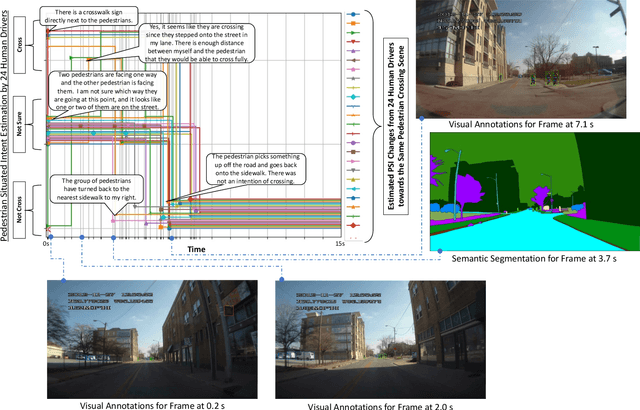


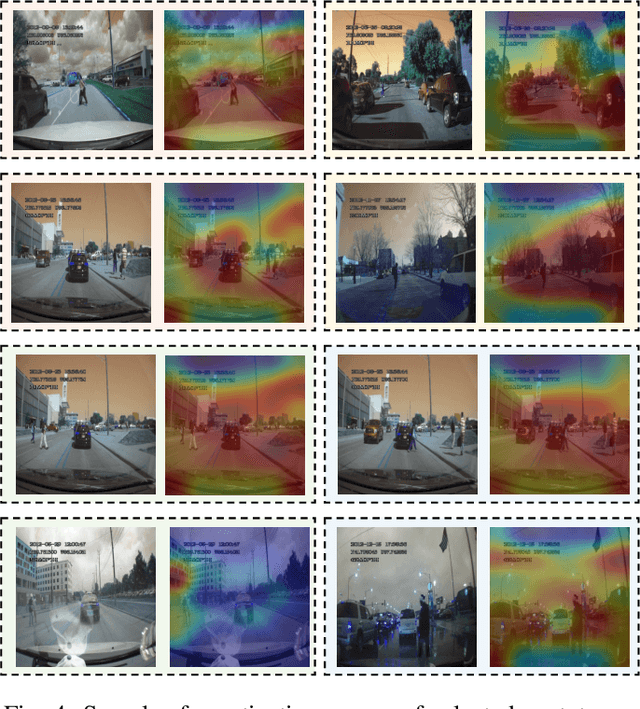
Abstract:Prediction of pedestrian behavior is critical for fully autonomous vehicles to drive in busy city streets safely and efficiently. The future autonomous cars need to fit into mixed conditions with not only technical but also social capabilities. As more algorithms and datasets have been developed to predict pedestrian behaviors, these efforts lack the benchmark labels and the capability to estimate the temporal-dynamic intent changes of the pedestrians, provide explanations of the interaction scenes, and support algorithms with social intelligence. This paper proposes and shares another benchmark dataset called the IUPUI-CSRC Pedestrian Situated Intent (PSI) data with two innovative labels besides comprehensive computer vision labels. The first novel label is the dynamic intent changes for the pedestrians to cross in front of the ego-vehicle, achieved from 24 drivers with diverse backgrounds. The second one is the text-based explanations of the driver reasoning process when estimating pedestrian intents and predicting their behaviors during the interaction period. These innovative labels can enable several computer vision tasks, including pedestrian intent/behavior prediction, vehicle-pedestrian interaction segmentation, and video-to-language mapping for explainable algorithms. The released dataset can fundamentally improve the development of pedestrian behavior prediction models and develop socially intelligent autonomous cars to interact with pedestrians efficiently. The dataset has been evaluated with different tasks and is released to the public to access.
Towards Novel Target Discovery Through Open-Set Domain Adaptation
May 16, 2021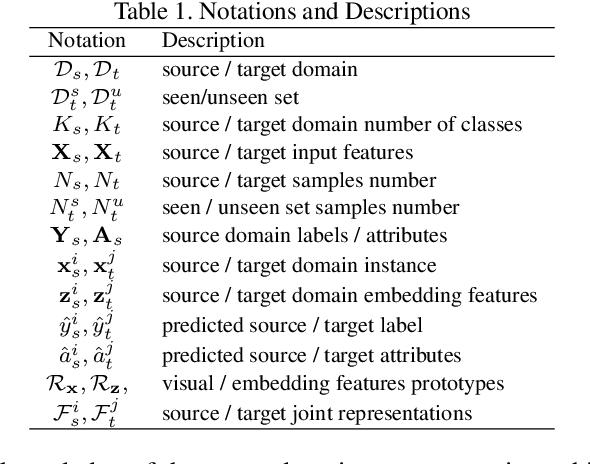



Abstract:Open-set domain adaptation (OSDA) considers that the target domain contains samples from novel categories unobserved in external source domain. Unfortunately, existing OSDA methods always ignore the demand for the information of unseen categories and simply recognize them as "unknown" set without further explanation. This motivates us to understand the unknown categories more specifically by exploring the underlying structures and recovering their interpretable semantic attributes. In this paper, we propose a novel framework to accurately identify the seen categories in target domain, and effectively recover the semantic attributes for unseen categories. Specifically, structure preserving partial alignment is developed to recognize the seen categories through domain-invariant feature learning. Attribute propagation over visual graph is designed to smoothly transit attributes from seen to unseen categories via visual-semantic mapping. Moreover, two new cross-main benchmarks are constructed to evaluate the proposed framework in the novel and practical challenge. Experimental results on open-set recognition and semantic recovery demonstrate the superiority of the proposed method over other compared baselines.
Adversarial Dual Distinct Classifiers for Unsupervised Domain Adaptation
Aug 27, 2020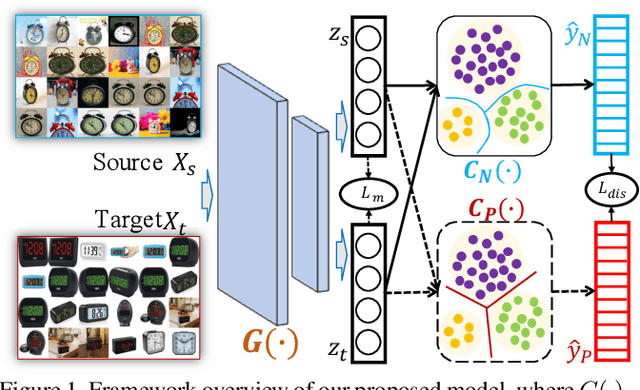
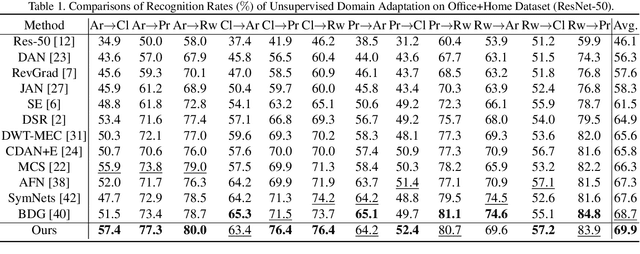


Abstract:Unsupervised Domain adaptation (UDA) attempts to recognize the unlabeled target samples by building a learning model from a differently-distributed labeled source domain. Conventional UDA concentrates on extracting domain-invariant features through deep adversarial networks. However, most of them seek to match the different domain feature distributions, without considering the task-specific decision boundaries across various classes. In this paper, we propose a novel Adversarial Dual Distinct Classifiers Network (AD$^2$CN) to align the source and target domain data distribution simultaneously with matching task-specific category boundaries. To be specific, a domain-invariant feature generator is exploited to embed the source and target data into a latent common space with the guidance of discriminative cross-domain alignment. Moreover, we naturally design two different structure classifiers to identify the unlabeled target samples over the supervision of the labeled source domain data. Such dual distinct classifiers with various architectures can capture diverse knowledge of the target data structure from different perspectives. Extensive experimental results on several cross-domain visual benchmarks prove the model's effectiveness by comparing it with other state-of-the-art UDA.
Adaptively-Accumulated Knowledge Transfer for Partial Domain Adaptation
Aug 27, 2020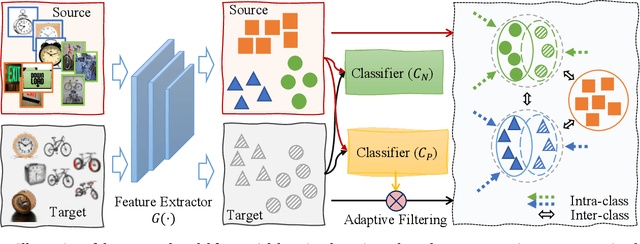
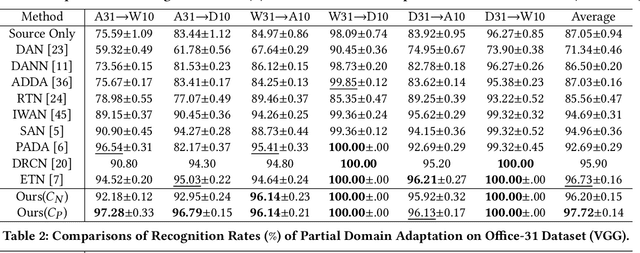
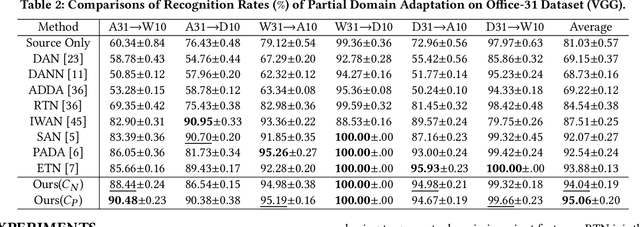

Abstract:Partial domain adaptation (PDA) attracts appealing attention as it deals with a realistic and challenging problem when the source domain label space substitutes the target domain. Most conventional domain adaptation (DA) efforts concentrate on learning domain-invariant features to mitigate the distribution disparity across domains. However, it is crucial to alleviate the negative influence caused by the irrelevant source domain categories explicitly for PDA. In this work, we propose an Adaptively-Accumulated Knowledge Transfer framework (A$^2$KT) to align the relevant categories across two domains for effective domain adaptation. Specifically, an adaptively-accumulated mechanism is explored to gradually filter out the most confident target samples and their corresponding source categories, promoting positive transfer with more knowledge across two domains. Moreover, a dual distinct classifier architecture consisting of a prototype classifier and a multilayer perceptron classifier is built to capture intrinsic data distribution knowledge across domains from various perspectives. By maximizing the inter-class center-wise discrepancy and minimizing the intra-class sample-wise compactness, the proposed model is able to obtain more domain-invariant and task-specific discriminative representations of the shared categories data. Comprehensive experiments on several partial domain adaptation benchmarks demonstrate the effectiveness of our proposed model, compared with the state-of-the-art PDA methods.
Discriminative Cross-Domain Feature Learning for Partial Domain Adaptation
Aug 26, 2020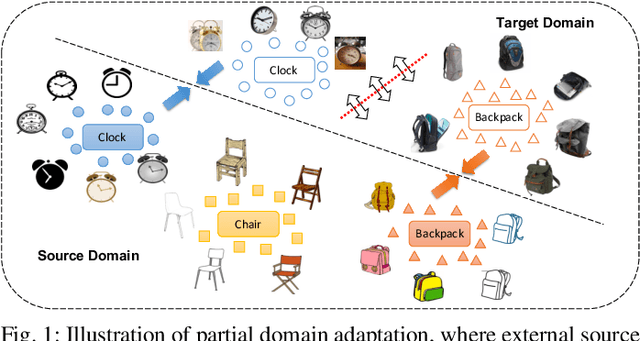
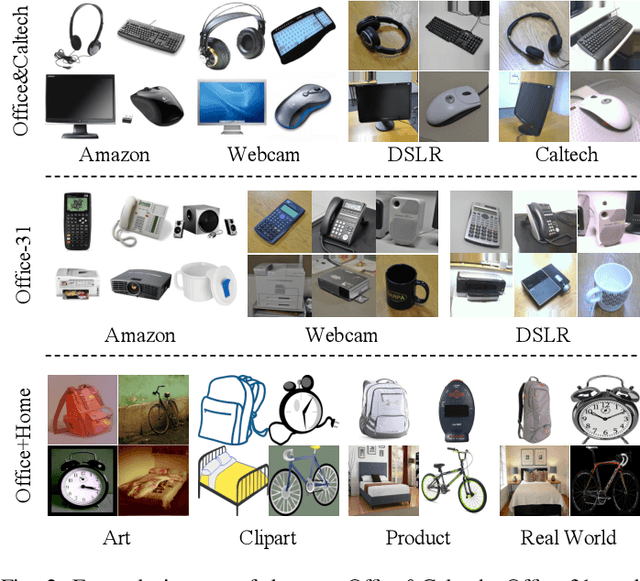
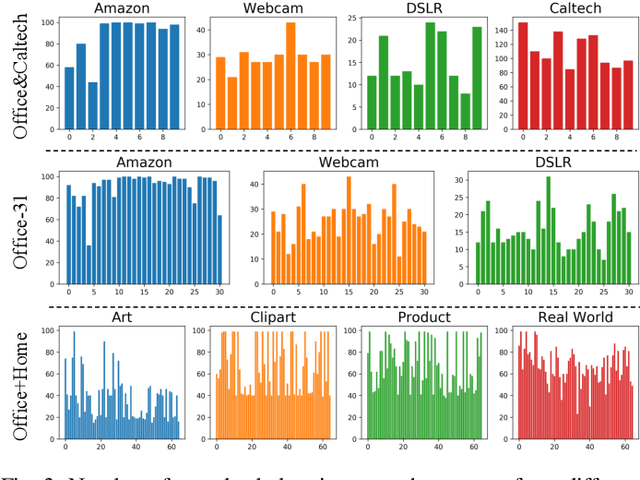
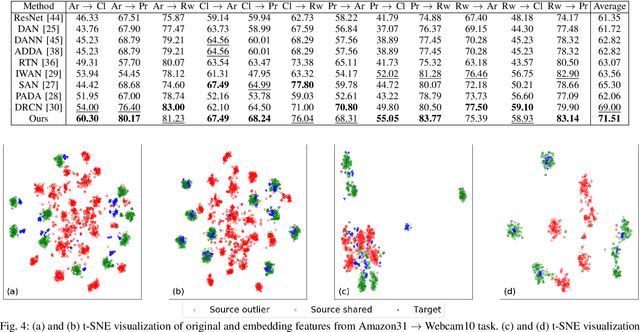
Abstract:Partial domain adaptation aims to adapt knowledge from a larger and more diverse source domain to a smaller target domain with less number of classes, which has attracted appealing attention. Recent practice on domain adaptation manages to extract effective features by incorporating the pseudo labels for the target domain to better fight off the cross-domain distribution divergences. However, it is essential to align target data with only a small set of source data. In this paper, we develop a novel Discriminative Cross-Domain Feature Learning (DCDF) framework to iteratively optimize target labels with a cross-domain graph in a weighted scheme. Specifically, a weighted cross-domain center loss and weighted cross-domain graph propagation are proposed to couple unlabeled target data to related source samples for discriminative cross-domain feature learning, where irrelevant source centers will be ignored, to alleviate the marginal and conditional disparities simultaneously. Experimental evaluations on several popular benchmarks demonstrate the effectiveness of our proposed approach on facilitating the recognition for the unlabeled target domain, through comparing it to the state-of-the-art partial domain adaptation approaches.
EV-Action: Electromyography-Vision Multi-Modal Action Dataset
Apr 20, 2019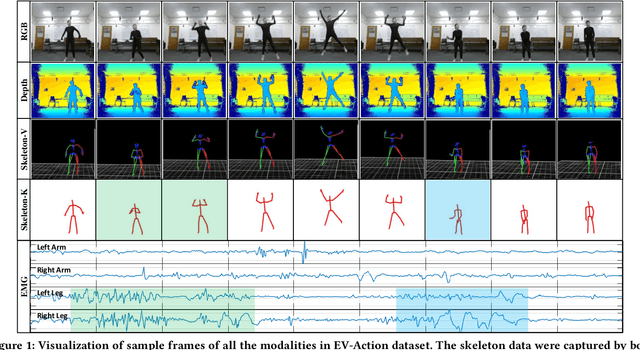

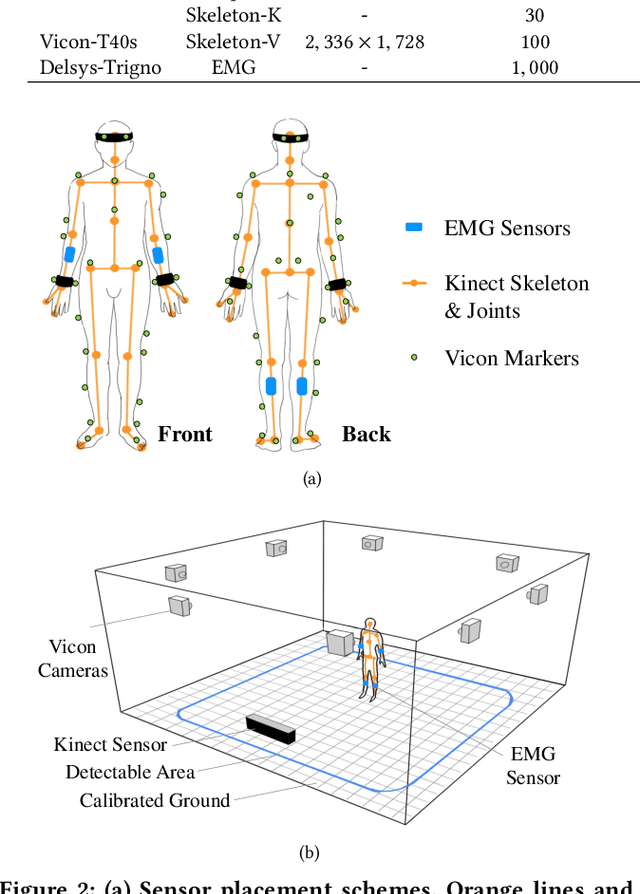
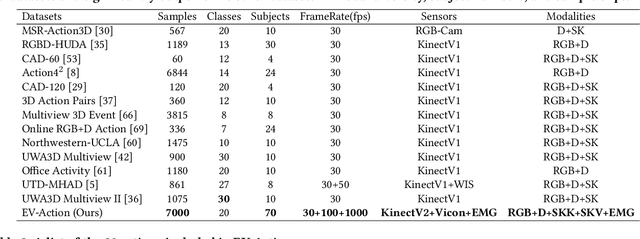
Abstract:Multi-modal human motion analysis is a critical and attractive research topic. Most existing multi-modal action datasets only provide visual modalities such as RGB, depth, or low quality skeleton data. In this paper, we introduce a new, large-scale dataset named EV-Action dataset. It consists RGB, depth, electromyography (EMG), and two skeleton modalities. Compared with others, our dataset has two major improvements: (1) we deploy a motion capturing system to obtain high quality skeleton modality, which provides more comprehensive motion information including skeleton, trajectory, and acceleration with higher accuracy, sample frequency, and more skeleton markers. (2) we include an EMG modality. While EMG is used as an effective indicator for biomechanics area, it has yet to be well explored in multimedia, computer vision, and machine learning areas. To the best of our knowledge, this is the first action dataset with EMG modality. In this paper, we introduce the details of EV-Action dataset. A simple yet effective framework for EMG-based action recognition is proposed. Moreover, we provide state-of-the-art baselines for each modality. The approaches achieve considerable improvements when EMG is involved, and it demonstrates the effectiveness of EMG modality in human action analysis tasks. We hope this dataset could make significant contributions to signal processing, multimedia, computer vision, machine learning, biomechanics, and other interdisciplinary fields.
 Add to Chrome
Add to Chrome Add to Firefox
Add to Firefox Add to Edge
Add to Edge